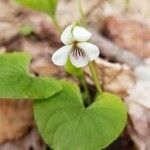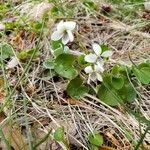Plants perennial, acaulescent, not stoloniferous, 5–30 cm; rhizome thick, fleshy. Leaves basal, 1–5, prostrate to ascending; stipules linear-lanceolate, margins entire to sparsely laciniate, apex acute; petiole 3–10 cm, strigose, sericeous, or villous, occasionally glabrous; blade unlobed, reniform or ovate to broadly ovate or orbiculate, 1.5–3.5 × 2–5 cm, base cordate to broadly cordate, margins serrate-crenate, ciliate or eciliate, apex acute, obtuse, or rounded, occasionally acuminate, surfaces usually sparsely to densely strigose, sericeous, or villous throughout or along veins, sometimes glabrous. Peduncles 3–8 cm, puberulent. Flowers: sepals lanceolate to ovate, margins usually eciliate, auricles 1–2 mm; petals white on both surfaces, lower 3 purple-veined, all beardless or lower 3 sparsely bearded, lowest 8–10 mm, spur white, gibbous, 2–3 mm; style head beardless; cleistogamous flowers on prostrate to ascending peduncles. Capsules ovoid to ellipsoid, 5–8 mm, glabrous. Seeds mottled beige to bronze, 1.5–2.2 mm. 2n = 24.
More
Rhizome elongate, becoming stout and scaly; stolons wanting; lvs reniform to reniform-cordate, distantly crenate-serrate, rounded above or shortly blunt-tipped, variously hairy on both sides, or on the lower surface only, or wholly glabrous; fls 7–10 mm wide; sep narrowly lanceolate; pet white, all beardless or bearded, the 3 lower with brown-purple veins near the base, the spur short and rounded; frs ellipsoid, 4–5 mm, the cleistogamous ones on horizontal to erect peduncles; seeds brown with darker marks; 2n=24. Arbor-vitae swamps and cold woods; Nf. to B.C., s. to Mass., Conn., N.Y., Mich., Minn., and Colo. May–July.



